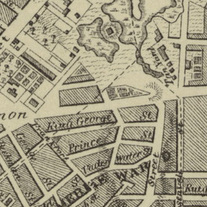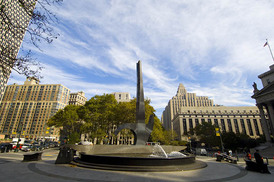Execution Grounds
The year 1741 started out badly. Poor whites and blacks lived in fear of freezing or starving to death. There were food shortages and the winter set records as the coldest known. And then there were fires. First the governor’s house in Fort George burned to the ground. Then there were four fires in one day. People panicked, thinking it was a slave uprising—their worst fear. Africans were one-fifth of the community’s population, and there had been violent uprisings in the past and in other places. A hunt for the conspirators began, as more fires were set.
In this climate of hysteria, a grand jury quickly agreed that there was a plot to burn the city and kill its inhabitants. It was thought that there were ringleaders and that they must be white. The first arrested, mostly black men and a few whites, were thrown into jail in the basement of City Hall, where they were questioned and probably beaten. Large rewards, including freedom from indenture, were offered to any who would give evidence. An indentured servant named Mary Burton was the first to name names. She described a great plot, led by white ringleaders. This was just what the investigators wanted to hear. Soon others agreed to give names. It was not long before 160 black and 21 white men and women were arrested in “The Great Negro Plot.”
At trial the accused had no legal representation. All the lawyers were working for the prosecution. At least 34 people were convicted and brought to the Execution Grounds. Seventeen blacks were hanged, as well as four white “ringleaders.” Thirteen Africans were burned at the stake. The events were remembered as the “Bonfires of the Negroes.” An additional 70 enslaved African Americans were shipped to the Caribbean and sold.
This entry contributed by
Curriculum Concepts International
Related Media
Video

|
Kenneth Jackson, Columbia University Professor of History, describes the execution grounds of New York City's colonial era.
|
Images

|
What was the execution grounds in 1741 is now Foley Square, located between Lafayette and Centre Streets. The four white people convicted in the plot were hung near the East River.
|

|
During the hysteria of the “Great Negro Plot,” 17 African Americans were hung and 13 were burned at the stake. The execution grounds were located on the African Burial Ground.
|





